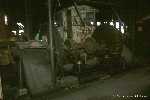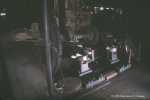



Building: Machine Shop
Machine Power: belt
HAER Map Key:
G
Date Built: unknown
Manufacturer: William Sellers and Company
Model: unknown
Serail Number: 1216
Published Photos: AEBT 198; TMB 12
This large lathe was designed and built expecially to 'turn' large locomotive wheel sets. Turning machines the surface of the wheel where it contacts the rail. It is important that both the wheel and rail be properly contoured so to reduce wear. Over time locomotive wheels become cupped, with an indintation in the center of the tread where it susualy contacts the rail. Their flanges and also become thin after rubbin on the head of the rail too much. The Wheel Lathe performs this taks by reducing the dimater of the unworn areas and returning the wheel to a proper profile, albeit a bit smaller diamater.
The wheel set (a pair of wheels rigidly mounted on an axle) is remvoved from the Locomotvie with the Transverse Jack and rolled between the shop tracks to this lathe. The wheel set was hoisted into the lathed and held in with XXXX in the stocks on either side (the parts of the machine that hold and rotate the work piece.) Clamps are then fitted through the wheel spokes to hold them firmly to the large round faceplates of the stocks.
This lathe, like all the machine tools in the shops, had no power supply of its own and was drive by a leather belt from an overhead shaft. It has a X speed transmission through the stepped pulley system.
The wheel can only be turened so many times until there is not enough material left, usually in the flange, to restore the contour. Rather than replacing an entire wheel, steam locomotive wheels are separated into the wheel center and the tire. The wheel center extends from the axle hole to within a few inches of the outsede. The tire is a ring of about four inches thickness that surrounds the wheel center and has the wear surface on its outside edge. When the wheel has lost it profile after its last turning, the tire is heated up with large torches or a "fire ring" (a ring shaped tube with several torch heds to apply heat along the tire.) As the tire heats up it expands and loostens from it friction fit to the wheel center. It can then be pounded off with hammers. A new tire, whose inside face has been machined to fit the wheel center, is then heated similarly and pounded on. A this point the tread life of the wheel has begun agin and an initial machining of the tread contour is performed. In this way wheels and axles usually last the life of the locomotive while only tires are changed out.
The Locomotive Wheel Lathe had two cutting tool holders so could machine both wheels on a wheelset at once. However if the wheel needed to be machined in the opposite direction, the set could be rolled out of the machine, turned on the Turntable to be rotated and place back in the machine. The freight car wheelset in the lathe for display is much smaller that the sets it regulary worked on.
The lathe may have been used in the 1960's to turn wheels commercially. It was used to turn wheel sets for the Rockhill Trolley Museum. It has not been used in some time due to its age and slow speed. When #14 was rebuilt in the late 1980's the wheels were sent to the Strasburg Railroad to be turned on a new faster and higher precision lathe.
Plate:
WILLIAM SELLERS & CO. INCORPORATED PHILADELPHIA No. 1216
Back to Machine Shop |
Click on an image to see larger version | Forward to Boring Machine | ||
|---|---|---|---|---|
| Up to Machine Shop. | ||||
| Up to South Wings. | ||||
| Tour Entry | Tour Index | Tour Info | ||